Rome
Lost in the pool of shadows. Un rifiuto comprensibile.
Vincenzo Agnetti, Sarah Margnetti, Cloti Ricciardi, Amelia Rosselli, Cinzia Ruggeri, Franca Sacchi, Suzanne Santoro, Roman Stanczak, Patrizia Vicinelli
curated by Luca Lo Pinto
June 8 – August 31, 2019
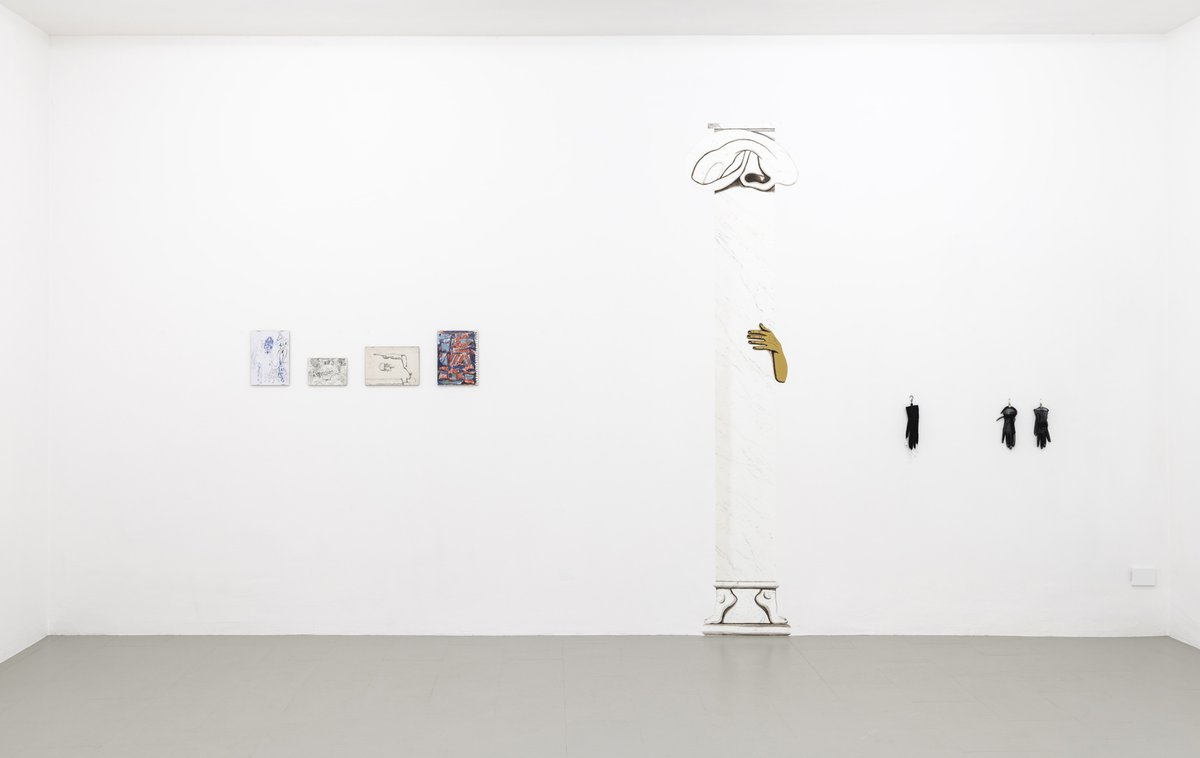
Lost in the pool of shadows. Un rifiuto comprensibile., 2019
Installation view
Layr, Rome
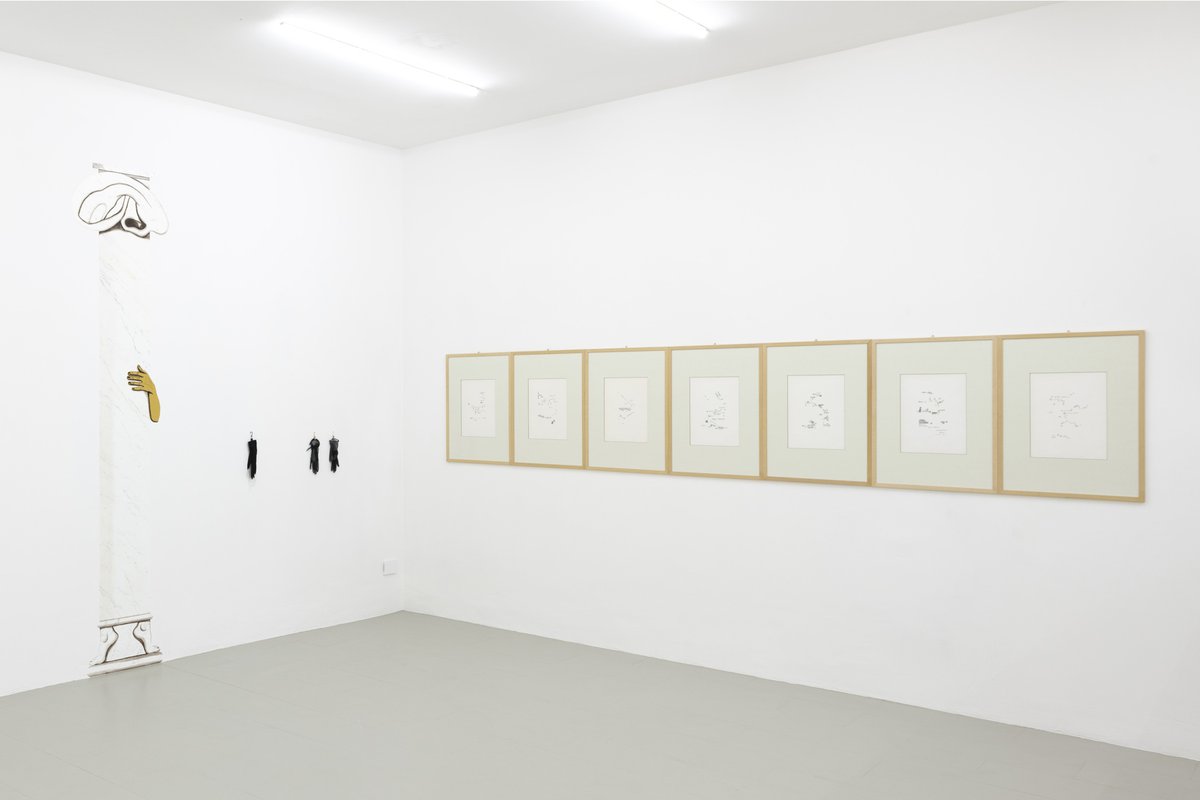
Lost in the pool of shadows. Un rifiuto comprensibile., 2019
Installation view
Layr, Rome
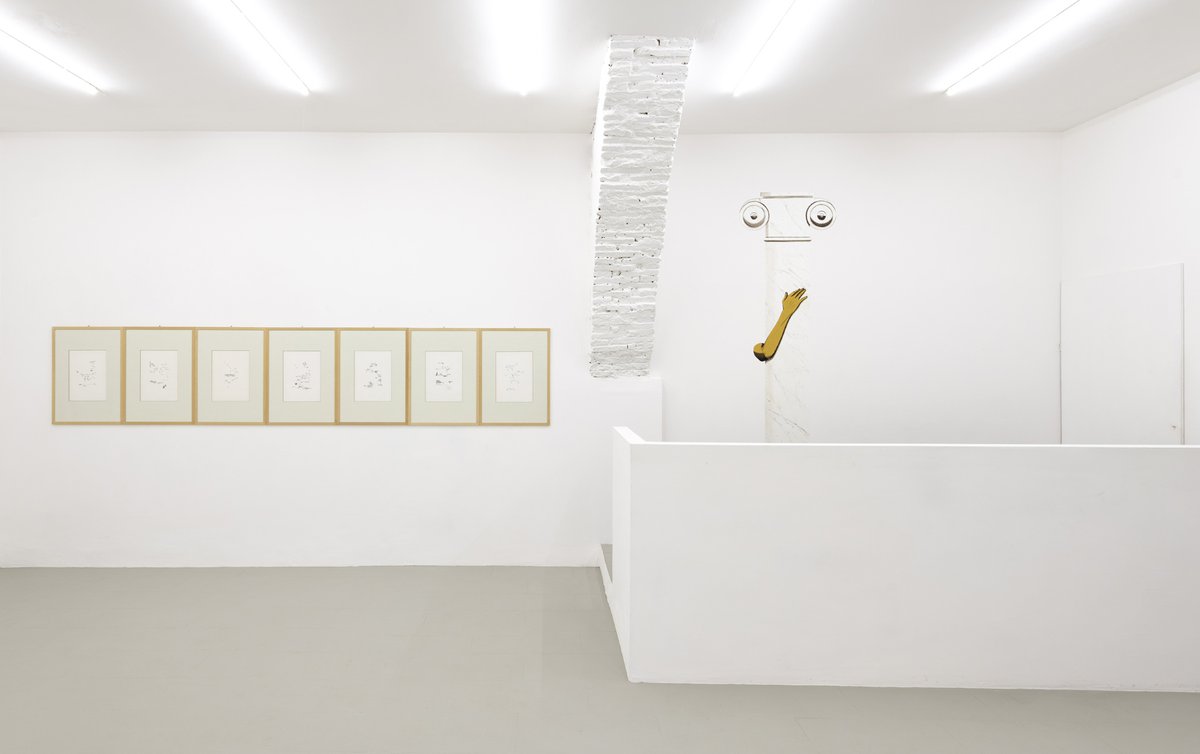
Lost in the pool of shadows. Un rifiuto comprensibile., 2019
Installation view
Layr, Rome
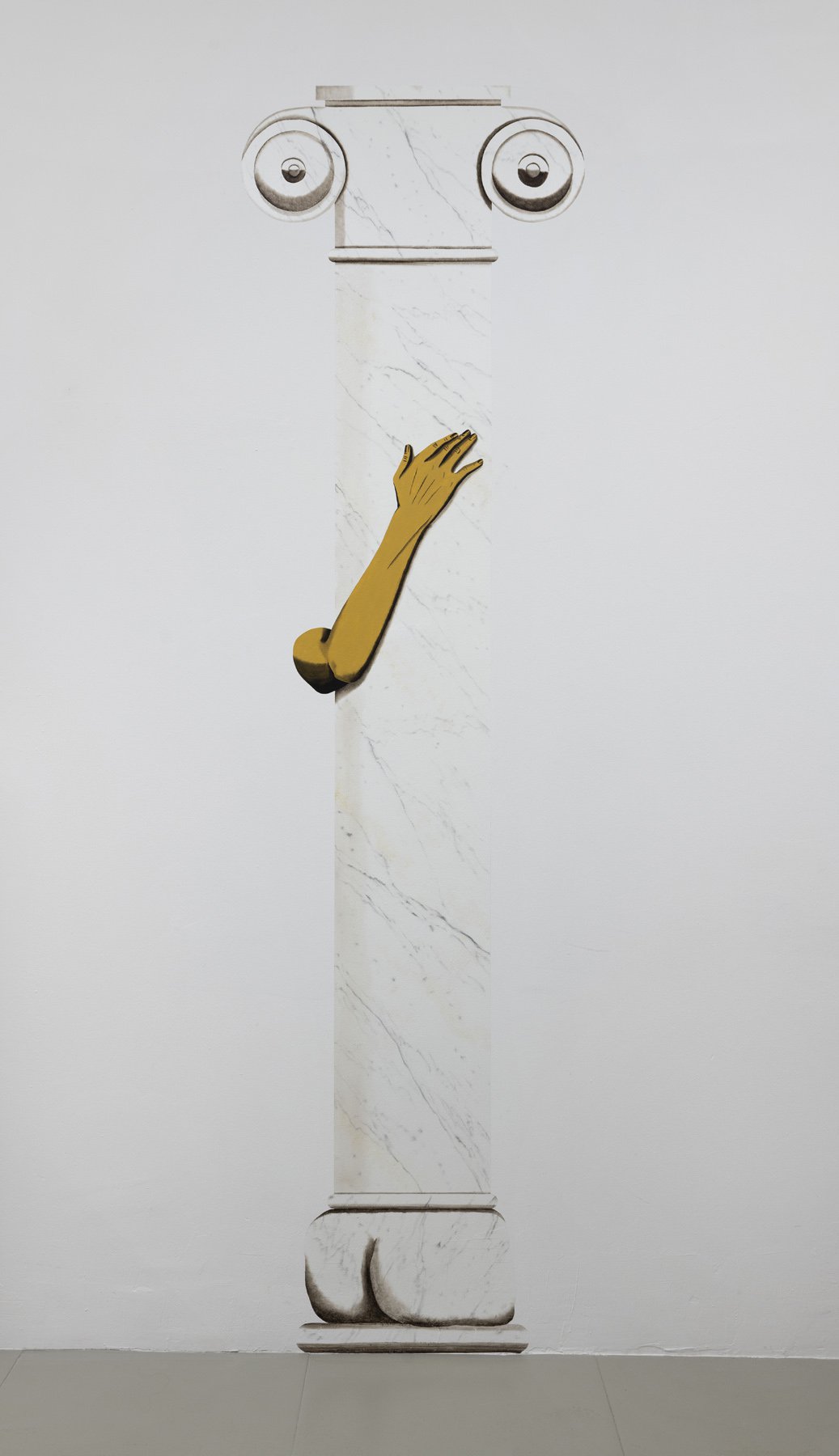
Sarah Margnetti
Caryatids, 2019
Oil painting and acrylic on wall
280 × 80 cm
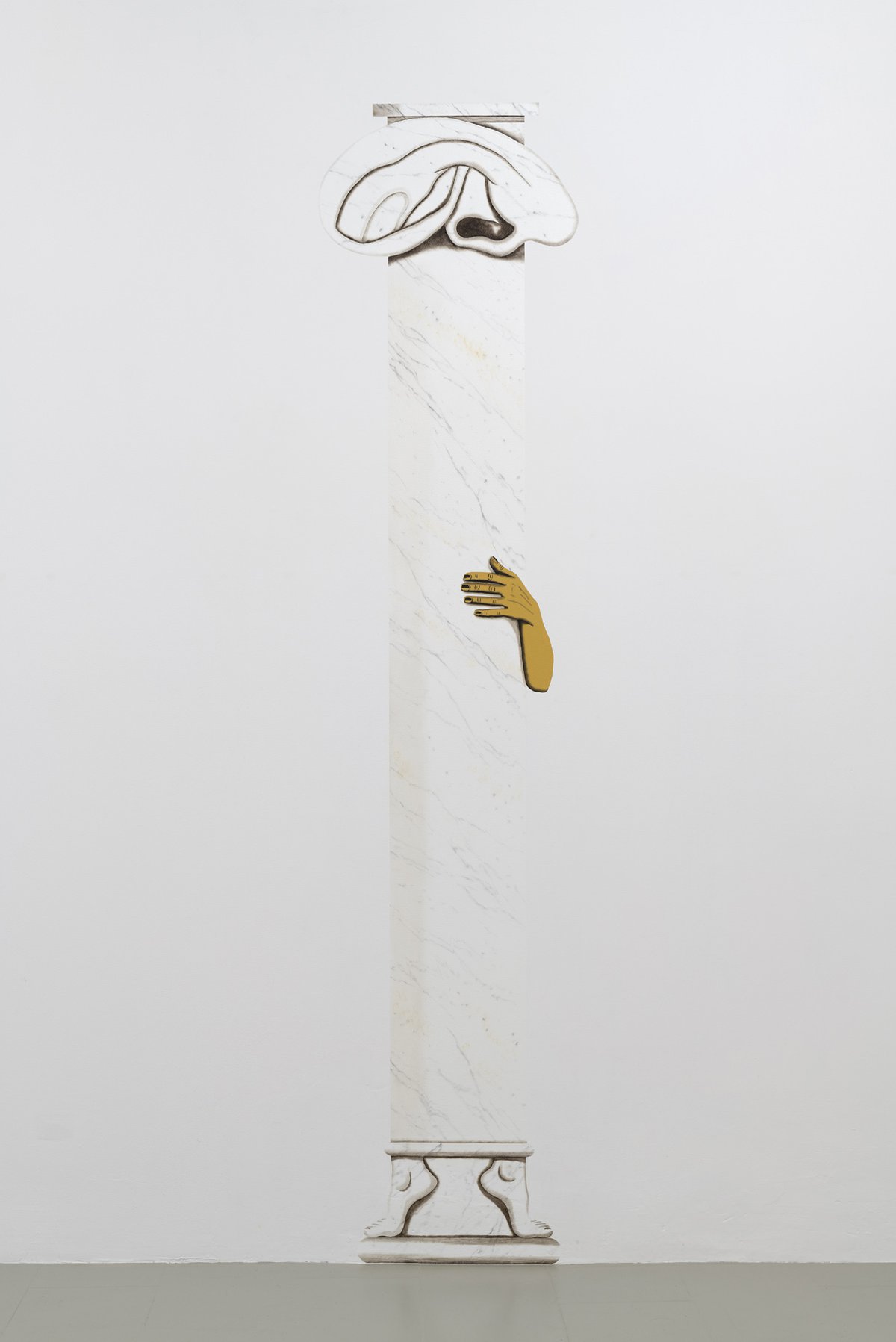
Sarah Margnetti
Caryatids, 2019
Oil painting and acrylic on wall
280 × 80 cm
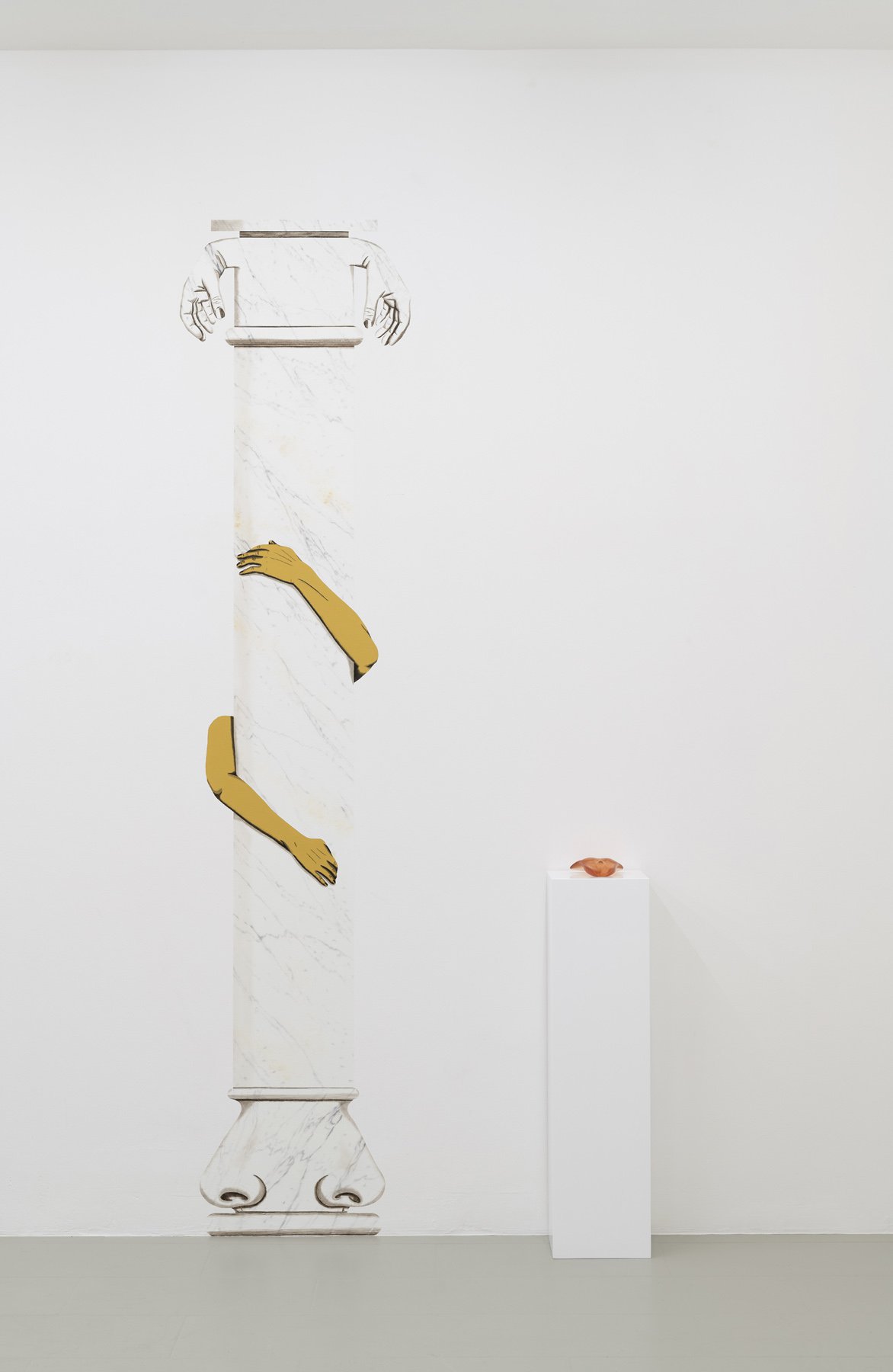
Lost in the pool of shadows. Un rifiuto comprensibile., 2019
Installation view
Layr, Rome
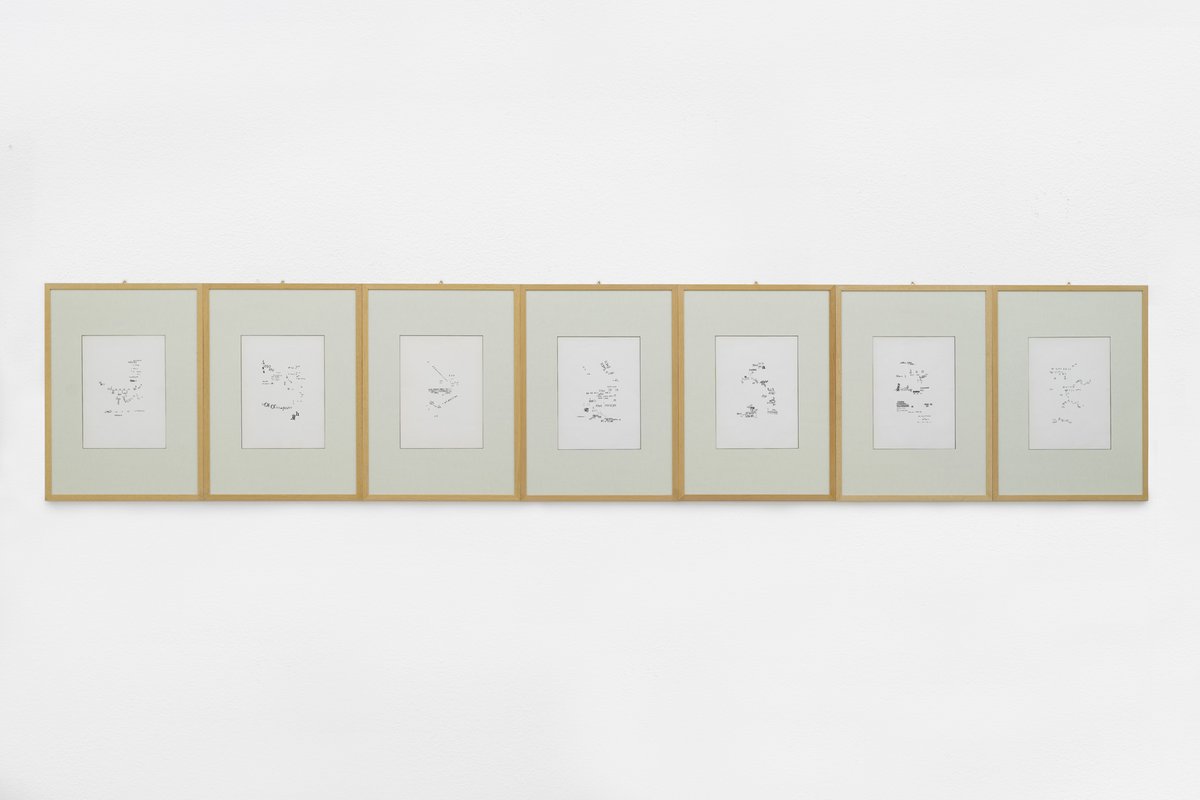
Patrizia Vicinelli
à, a. A (1/7), 1967
Seven silkscreens on cardboards
Each 74 × 54 × 2 cm
Private Collection
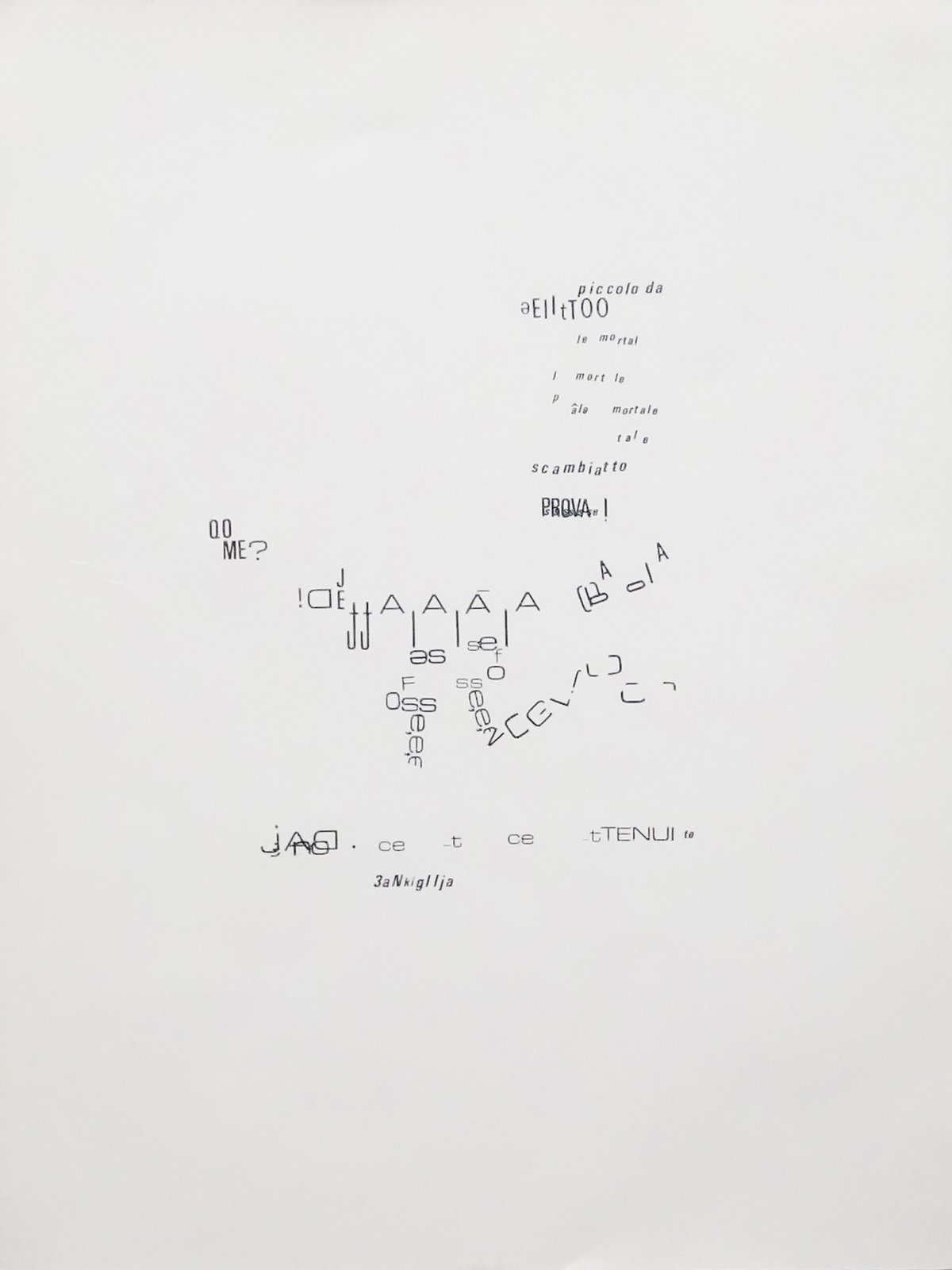
Patrizia Vicinelli
à, a. A (1/7), 1967
Seven silkscreens on cardboards
Each 74 × 54 × 2 cm
Private Collection
Detail view
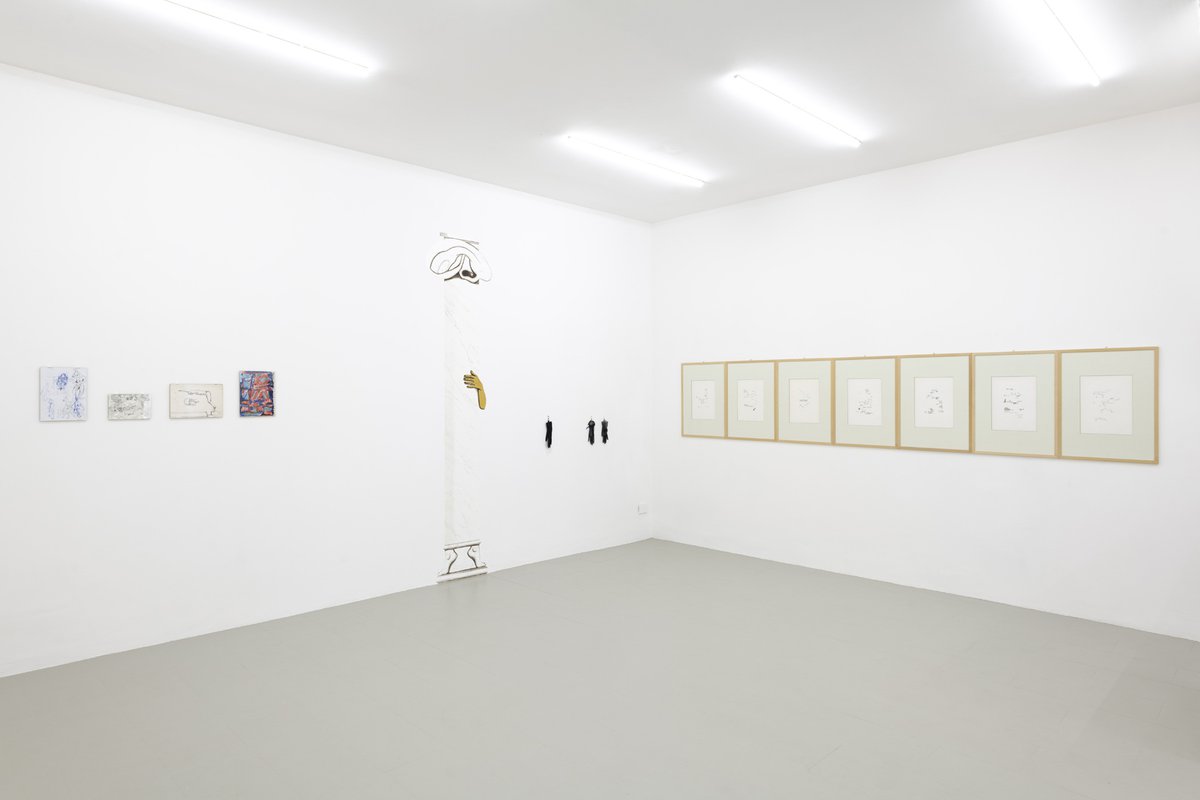
Lost in the pool of shadows. Un rifiuto comprensibile., 2019
Installation view
Layr, Rome
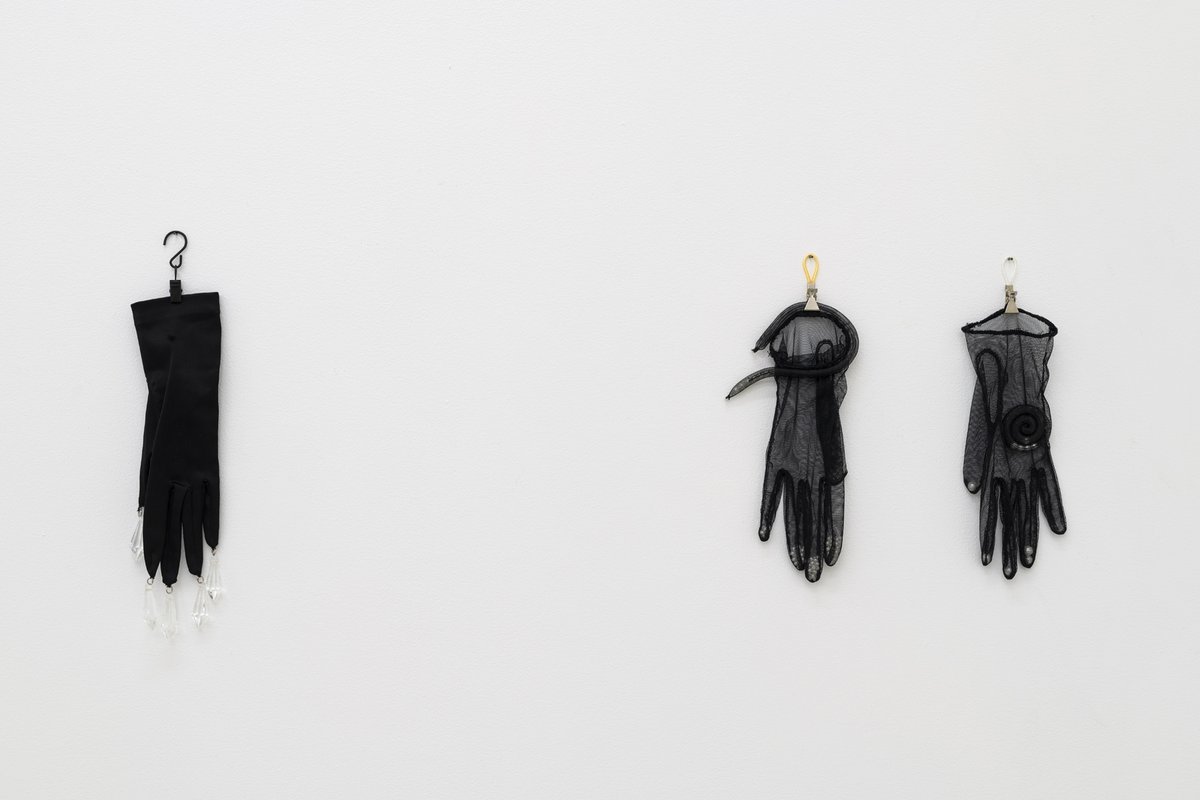
(left)
Cinzia Ruggeri
Guanto con cristalli (Glove with crystals), 1983
Satin glove, glass pendants
28 × 9 cm
(right)
Cinzia Ruggeri
Guanti con perle (Gloves with pearls), n.d.
Net gloves, synthetic pearls
26 × 7 cm
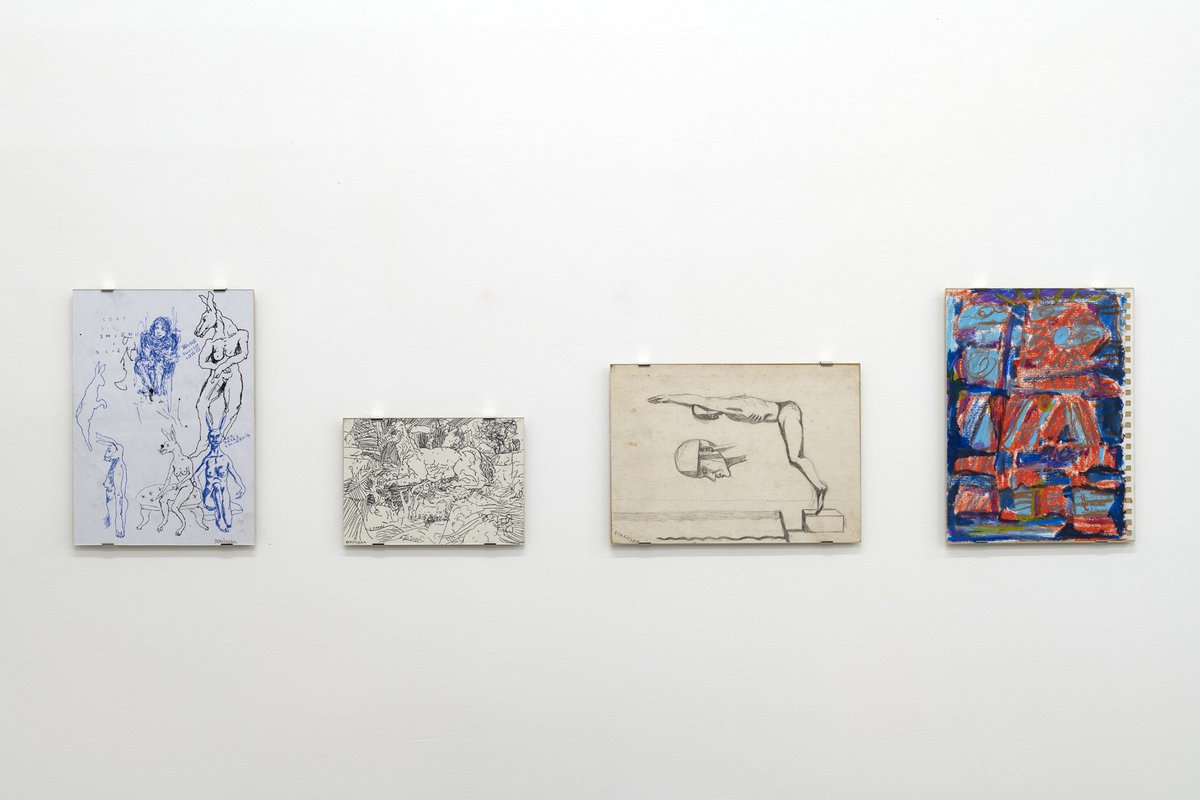
(left to right)
Roman Stańczak
Untitled, 2015
Ink on paper
29.5 × 21 cm
Untitled, 2015
Ink on paper
14.8 × 21 cm
Untitled, 2015
Pencil on cardboard
29.7 × 21 cm
Untitled, 2015
Wax crayons on paper
29.7 × 22 cm
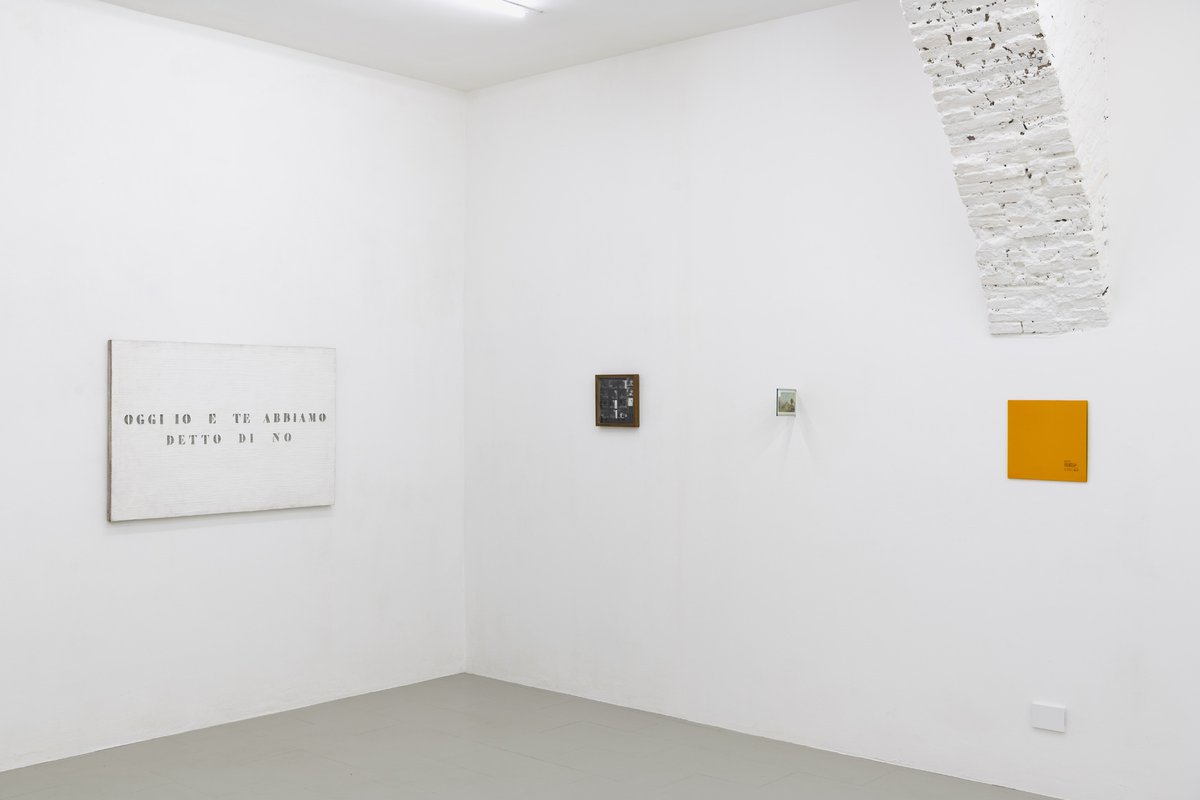
Lost in the pool of shadows. Un rifiuto comprensibile., 2019
Installation view
Layr, Rome
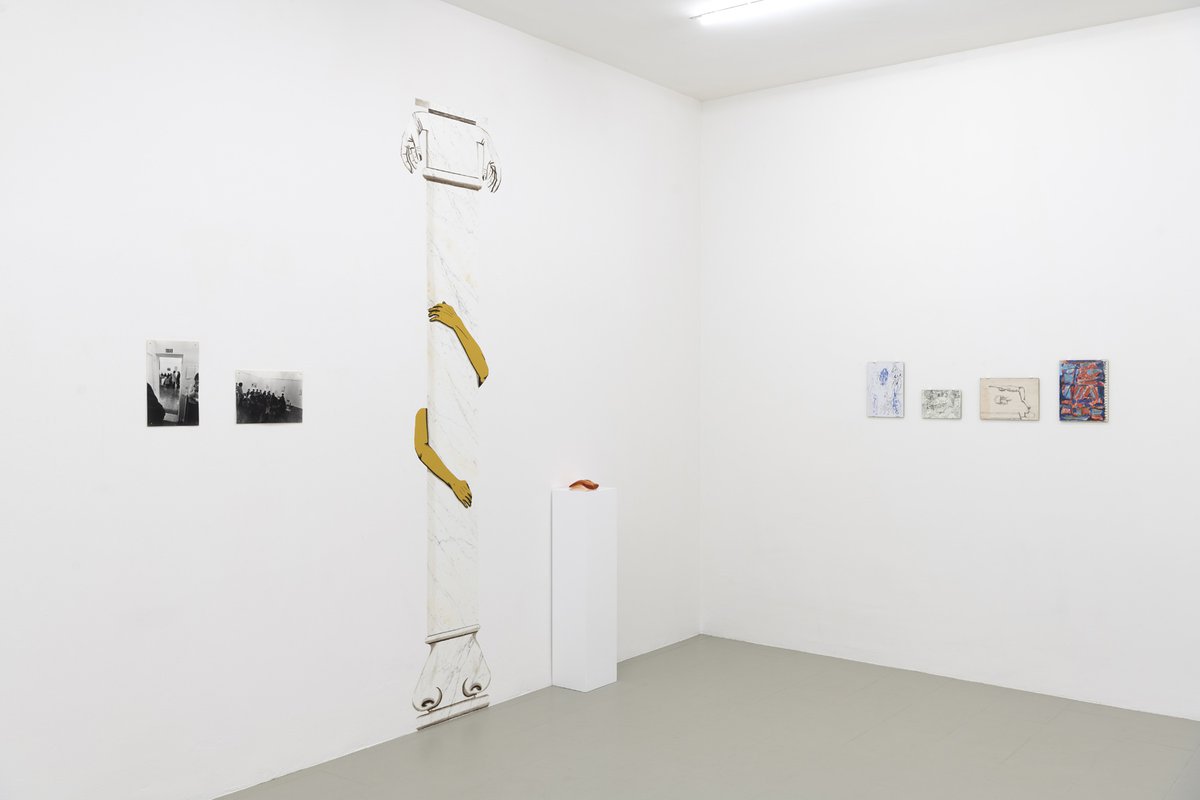
Lost in the pool of shadows. Un rifiuto comprensibile., 2019
Installation view
Layr, Rome
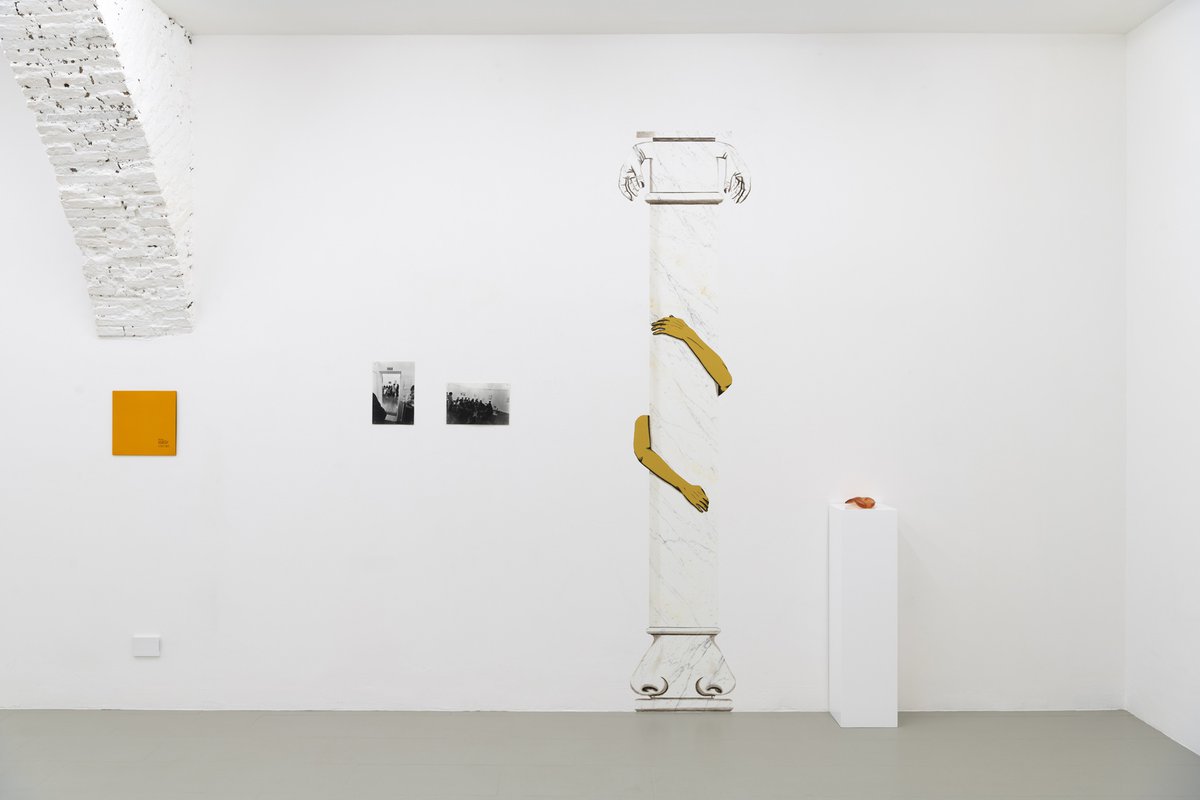
Lost in the pool of shadows. Un rifiuto comprensibile., 2019
Installation view
Layr, Rome
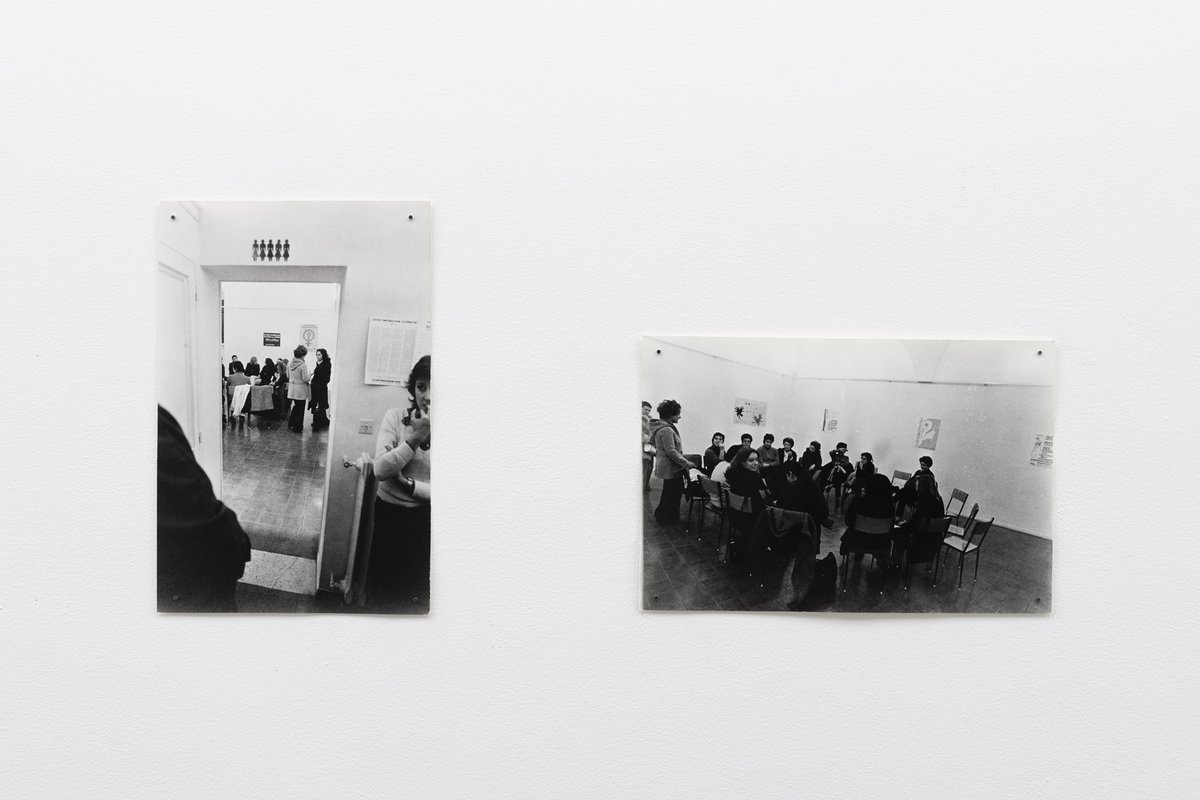
Cloti Ricciardi
Vietato l'ingresso agli uomini, 1972
Vintage prints
Each 30 × 20 cm
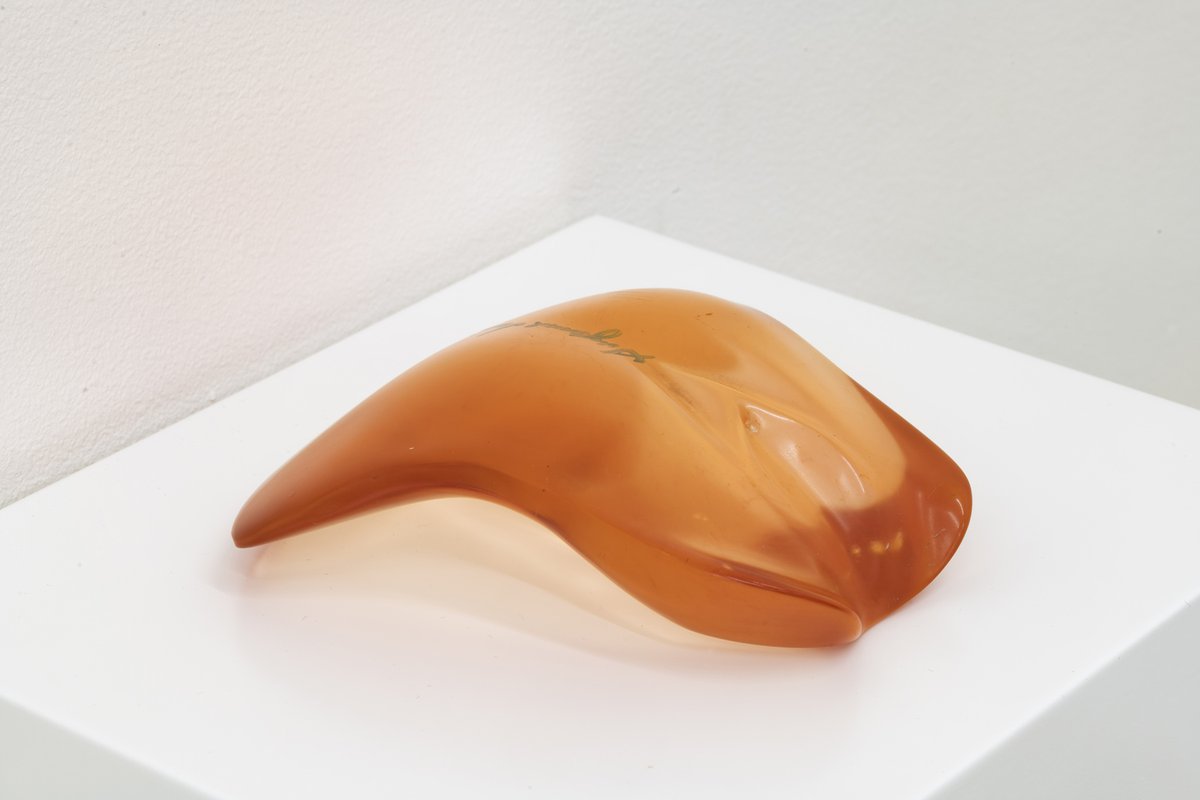
Suzanne Santoro
Mount of Venus and beyond, 1971
Resin cast
5 × 14 × 7 cm
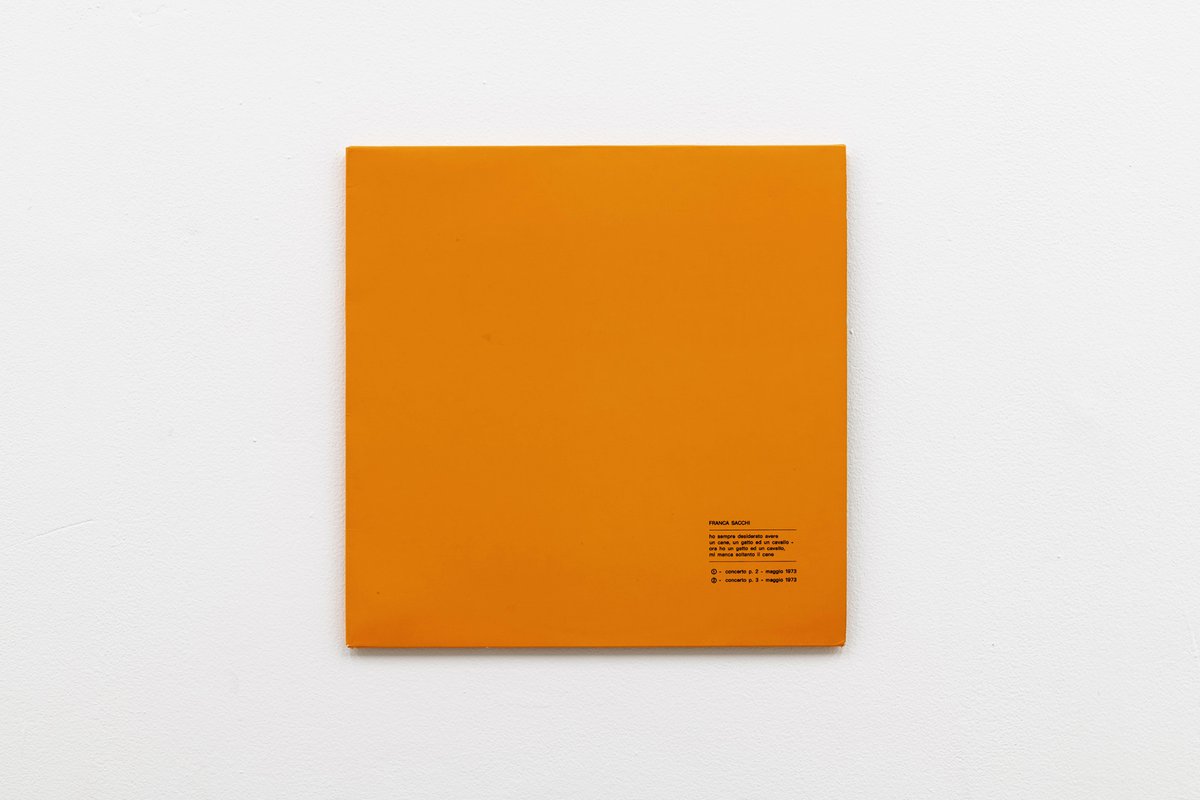
Franca Sacchi
Ho Sempre Desiderato Avere Un Cane, Un Gatto Ed Un Cavallo - Ora Ho Un Gatto Ed Un Cavallo, Mi Manca Soltanto Il Cane, 1973
Vinyl LP
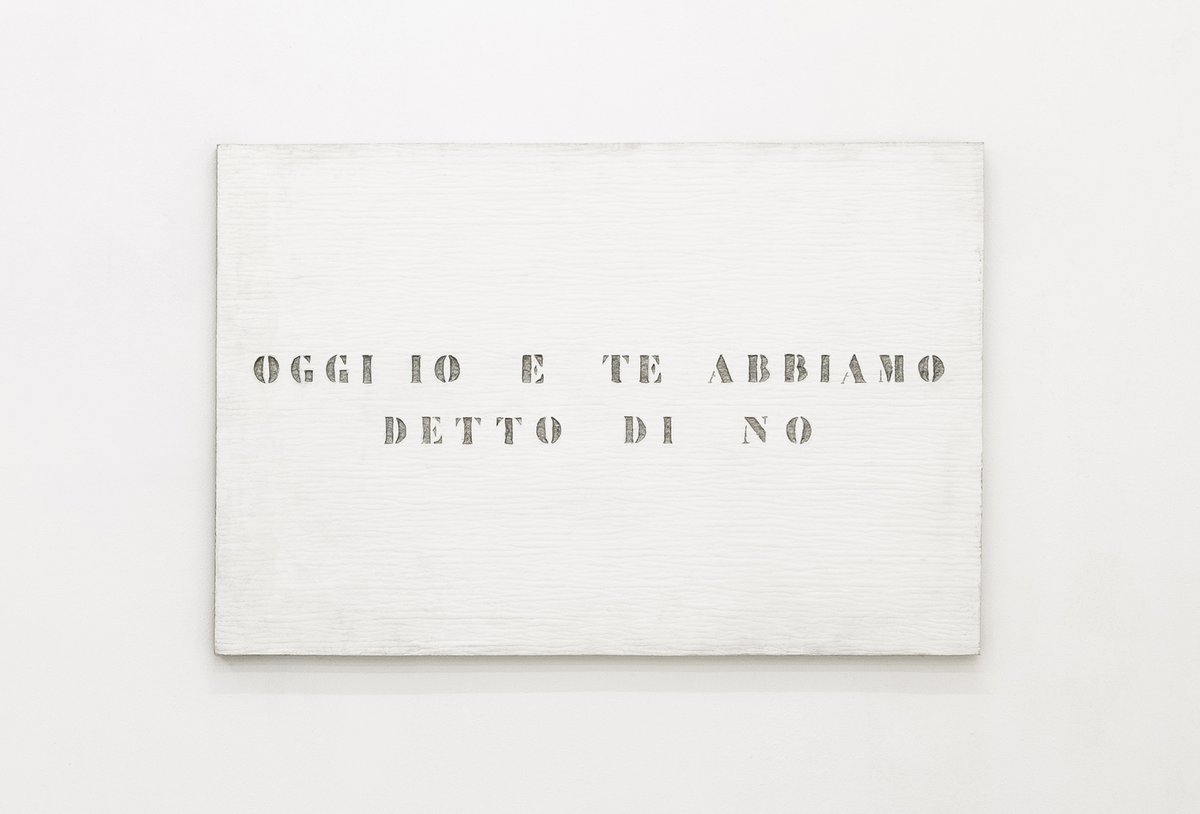
Vincenzo Agnetti
Ritratto – Oggi io e te abbiamo detto di no, 1971
Engraved and silver-painted inscription on white felt
80 × 120 cm
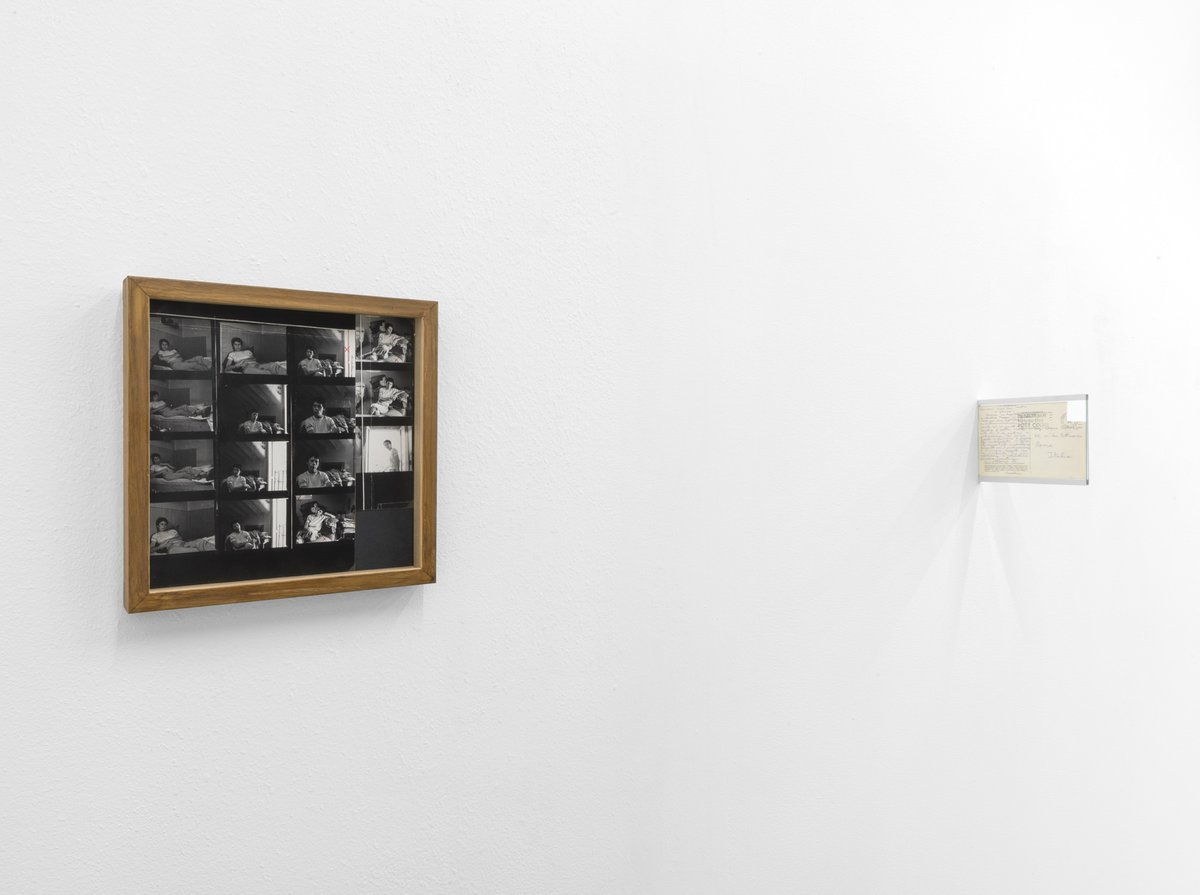
Lost in the pool of shadows. Un rifiuto comprensibile., 2019
Installation view
Layr, Rome
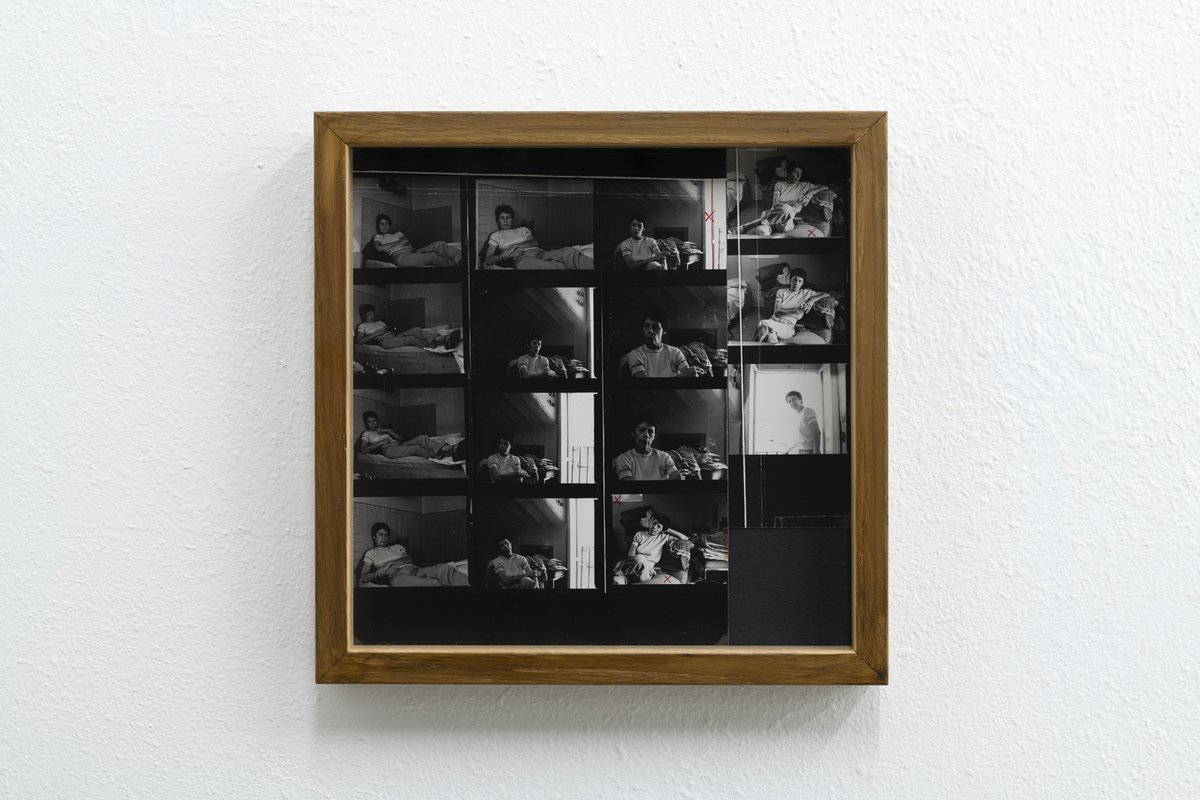
Dino Ignani
Portrait of Amelia Rosselli, 1980
Contact sheet
15 × 18 cm
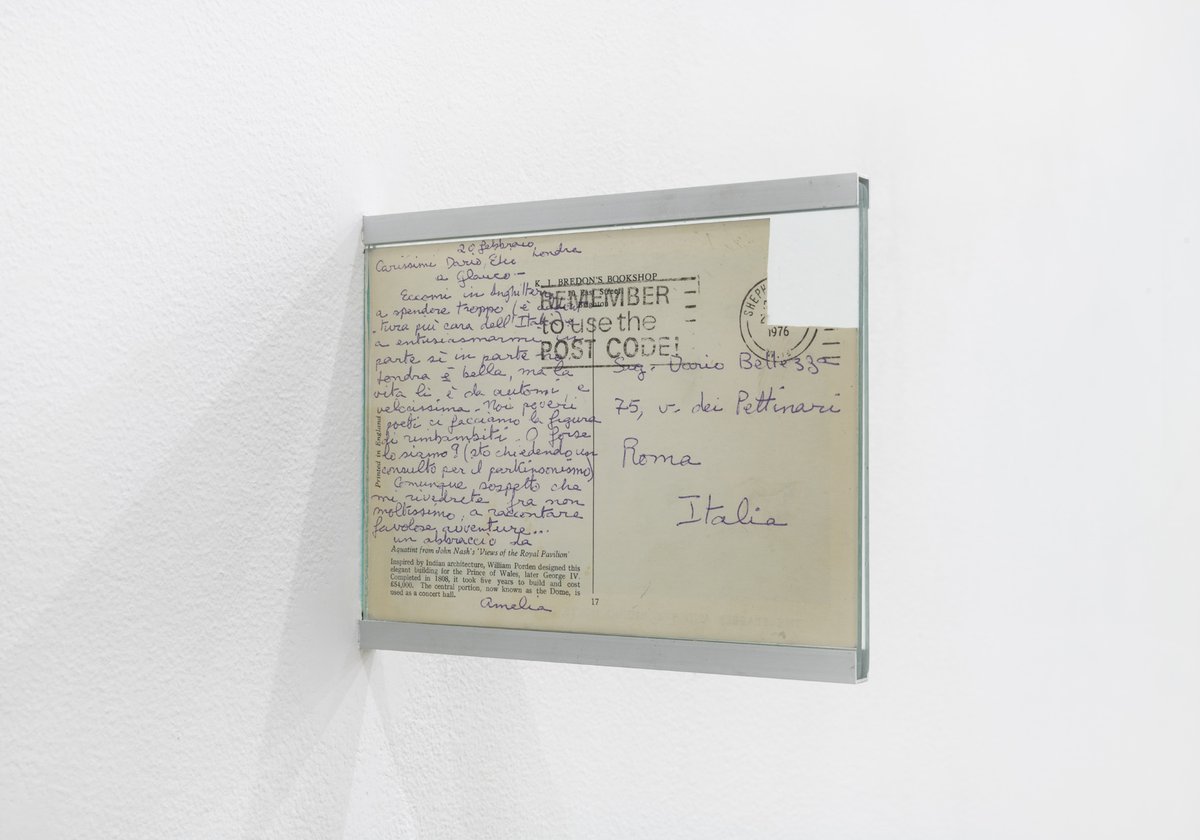
Amelia Rosselli
Post Card sent to Dario Bellezza, 20th February 1976, 1976
Post card
10.5 × 15 cm
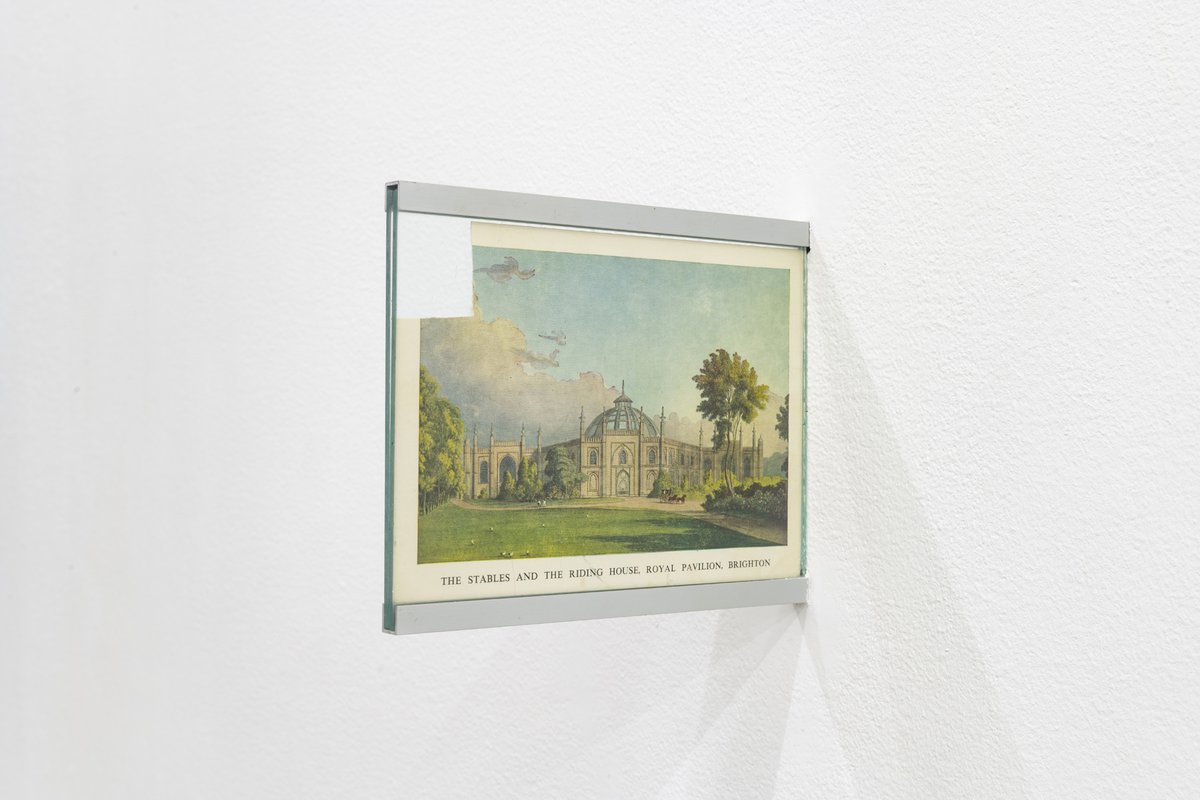
Amelia Rosselli
Post Card sent to Dario Bellezza, 20th February 1976, 1976
Post card
10.5 × 15 cm
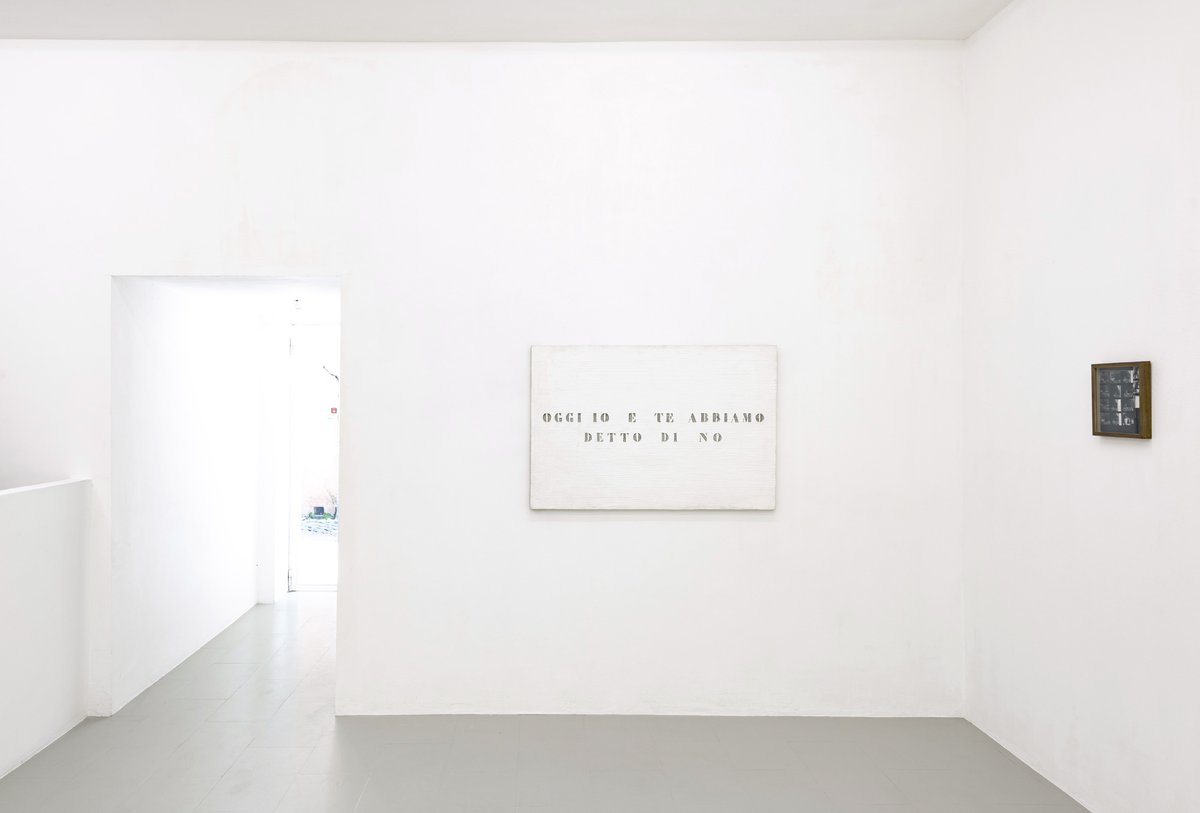
Lost in the pool of shadows. Un rifiuto comprensibile., 2019
Installation view
Layr, Rome
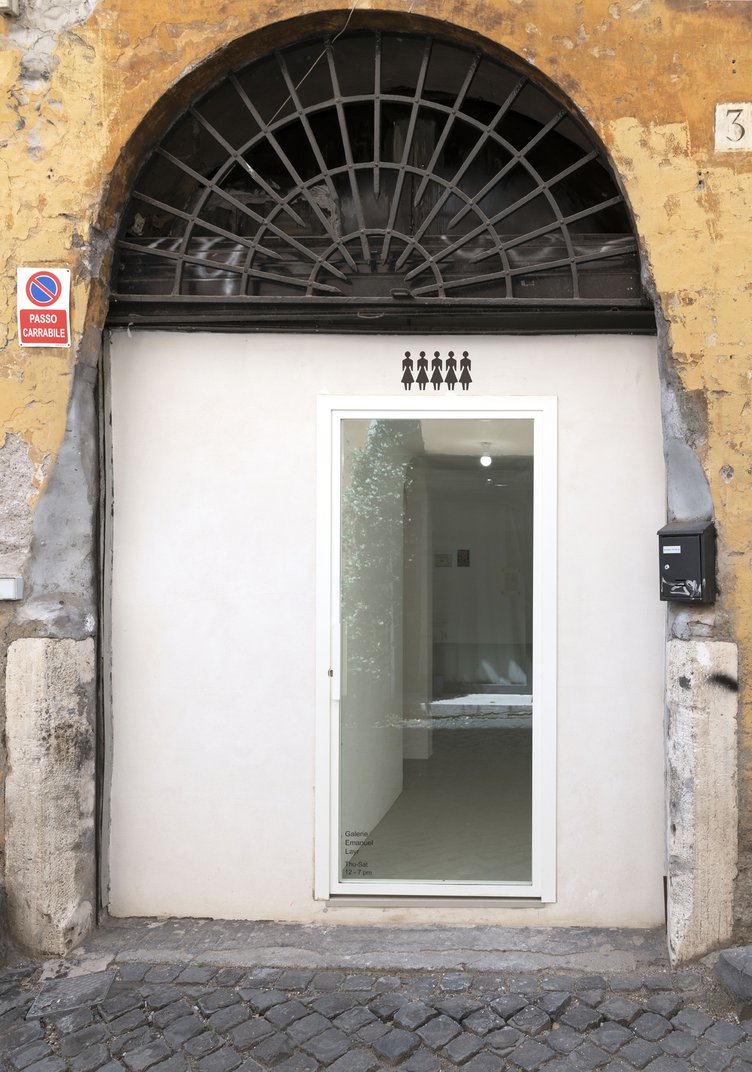
Cloti Ricciardi
Vietato l'ingresso agli uomini, 1972-2019
PVC stickers
25 × 16 cm
The exhibition brings together figures united by artistic practices and existences that are animated by a relationship of refusal, of confrontation and at the same time by the urgency of affirming their voices within the cultural system in which they have moved or still move. Most of the works featured were produced in a particular historical moment, the beginning of the ‘70s, animated by the aspiration to give life to utopias and by a form of resistance carried out on a linguistic and personal level. These artists share an intolerance of dominant structures, an emotional fragility, a sense of not belonging, a continuous desire to question themselves, an inseparable link between their personal experience and their art.
The subject of identity, the political instance, the relationship with the body are central themes in the work of Suzanne Santoro (1946) and Cloti Ricciardi (1939) with the need to redefine the female artistic subject dictated by the urgency of accessing a space – the world of art – dominated by men. Despite the fact that the feminism of the 1970s had penetrated the world of art and had fuelled a debate whose results are only now beginning to be seen, the feminist political struggle carried out by both the art world and the wider debate, although inseparable from artistic practice, has never fully identified with it.
While Vincenzo Agnetti (1926-1981) never clearly defined his political position, he did carry out an investigation into the role of language, time, communication and social criticism with great consistency. An outsider to any given movement, he often showed an ideological impatience with the artistic context in which he had taken his first steps by deciding to abandon painting in favour of a radical questioning the artwork.
Franca Sacchi (1940) was one of the very few female figures active on the Italian electronic music scene active between the late ‘60s and ‘70s, before abandoning art and experimental music to devote herself to teaching yoga, which she continues to do. Her album Ho sempre desiderato avere un cane, un gatto e un cavallo. Ora ho un gatto e un cavallo mi manca soltanto il cane (I always wanted to have a dog, a cat and a horse. Now I have a cat and a horse and I only miss the dog), published in 1973, will be the soundtrack to the exhibition.
Cinzia Ruggeri (1945) is a visionary artist and designer who in her creations combines fashion, architecture and design in a unique way that escapes any possible definition. She has experimented incessantly, pushing the language of fashion towards never before explored boundaries, designing all kinds of accessories including furniture, home interiors and theatrical sets. A surrealist imaginary that makes objects anew, making them interact with the body in an ironic and performative manner.
Roman Stanczak (1969) is a polish artist who studied at Grzegorz Kowalski’s workshop along with Pawel Althamer, Katarzyna Kozyra and Artur Zmijewski debuting on the art scene in the beginning of the ‘90s; producing a relevant and strong ensemble of works before withdrawing from the art world as soon as 1997. During these years of struggle with alcohol addiction, the artist produced a number of drawings depicting fairly-tales and a few figurative sculptures. His return was marked by the invitation of Pawel Althamer in 2013 to create a sculpture for a park in the Bródno neighbourhood of Warsaw. This year he represents Poland at the Venice Biennale.
Amelia Rosselli (1930-1996) is one of the most important voices of 20th century Italian poetry. The tragic experiences of her adolescence (the killing of her father by the fascists and various migrations between France, England, America and finally to Italy) evoked in her a sort of linguistic dissociation and a condition of permanent displacement, reflected in her use of language. Rosselli’s poetry – emotional, pained, cultured, sophisticated – represents a melee with reality that sadly ended with suicide in 1996.
In her brief and dramatic existence, Patrizia Vicinelli (1943- 1991) took part in the Italian neo-avant-garde scene by joining Gruppo 63 and collaborating with Emilio Villa in magazines such as Ex and Quindici. Vicinelli produced bold writing, situated between visual and sound poetry, with a strong performative calling, always dictated by a great intellectual force that has made her an influential figure in the underground literary and film scene. Her self-destructive nature led her to a restless existence studded with stories of drugs, prison and illness, depriving her of the recognition she deserved.
Sarah Margnetti (1983) studied at The Van der Kelen-Logelain Institute in Brussels, the longest established school in the world specialising in traditional decorative painting techniques. While there, the artist perfected the technique of trompe l’oeil, developing her own pictorial imagery combining optical illusions with abstract and surreal motifs often including parts of her body. Margnetti will conceive a wall painting for the exhibition that will also serve as an ideal backdrop for the other works on display.
– Luca Lo Pinto
A special thanks to all the artists and to Germana Agnetti, Bianca Boscu, Giuseppe Casetti, Mario Diacono, Giuseppe Garrera, Michal Lasota, Patrizio Peterlini, Massimo Piersanti, Mariolina Ricciardi.
Vincenzo Agnetti
My current works are a signal to vernacularize what I have learned, meaning my theoretical and critical research. I write things from which I derive my pictures, which in turn inspire other writings…
I think that anyone who looks at a work of this kind undergoes an act of mental violence before understanding the message; subsequently seeking to go into greater depth, to go forward and reach conclusions. And that, for me is the only way to get the visitor to continue to see the exhibition even after leaving the gallery.
Cloti Ricciardi
It was beautiful. It was a day for every artist. It happened to me on a Thursday, and Thursday was the day we had the Pompeo Magno meeting. Then I said “we’re going to do the Pompeo Magno at Palazzo Taverna!”. And so we did! Since it was a feminist meeting I made some female figures in perspex like those figures one puts outside the bathroom and I attached them to the door because it was forbidden for men to enter, in fact the exhibition was called just that: Vietato l’ingresso agli uomini (Forbidden for men to enter). We had our meeting quietly. The funny thing was that the door remained open and we witnessed the wrath of God! There was a kind of revolt from the men who wanted to enter. I was aware at the time that feminist collectives were at the avantgarde, but I lacked awareness of what it meant to bring feminism to a place dedicated to art, which does not possess a good understanding, let’s say. With hindsight, the fact that they were all women, the image of women arguing with all the men looking in from outside… the impact was incredible! The men reacted very badly and there were also many male artists who were indignant, they saw it as a presumptuous act, one of power. Not only could you not come and see why there was nothing to see, at most you stood outside and listened, but I don’t really care who was in or outside, this was outrage. It was a very powerful moment.
Amelia Rosselli
In truth, there are very close relations between my biography and my poetry, even if each of them obeys its own laws. Of course, the death of my father (and the way in which it happened) and all the consequent migrations that it obliged me to undertake have produced a sort of linguistic dissociation and a condition of permanent inconsistency. Language reflects such conditions. In fact, my concern is to effect a reconstitution, above all by setting the language of poetry to the rhythm of the laws of composition.
Cinzia Ruggeri
I love freedom and I hate prejudices, I just wanted to express myself and my ideas in a completely free environment and in different fields and make people smile.
Fashion allowed me to explore the wearer’s intimate secrets, needs and desires, but also a person’s crazes, fads and nervous disorders and I loved this aspect, as the entire point behind my work wasn’t to continuously and bulimically create, but to tackle and explore these issues through behavioural garments.
I never stopped creating for myself. Whenever I couldn’t find something that I liked, even a tablecloth, I would make it for myself, as a reaction to global and mass markets.
Franca Sacchi
At a certain point I realised that the “discourse on the evolution of musical language” not only didn’t interest me anymore, but also annoyed me. I felt it was false, forced, schizophrenic, imposed upon current ideology, from which, however, I did not have the courage to detach myself. I could no longer stand this alienated way of “making art”, this separation between art and life. I discovered, or rather, admitted that what really interested me was myself and my self development and that whatever I did towards it would automatically be reflected in my actions, in the manifestations of my existence.
Suzanne Santoro
I think, by now, that in life it is necessary to do what is necessary, not what you like to do. Before, my idea of art was simply that because I liked it, it gave me passion, it repaid me. Today, honestly, it no longer repays me as it used to. Elisabetta Rasy, a feminist and linguist writer, said something interesting, which is a theme already approached by feminists, “I work when I want to work”. That is to say, enough with this idea of the product, this idea of having to make something all the time, which is an attitude that unfortunately belongs very much to the world of art, this anxiety about producing, to be behind the galleries. Instead, Carla Lonzi says that we must re-evaluate the non- productive moments, even more so since, as women, we have been considered for centuries as non-productive in the world of culture. But there is a positive aspect to this if one considers what it is to be non-productive. It is the social, the conversation, the affection, the feeling that corresponds to life.
Roman Stanczak
I am constantly in some kind of conflict, an existential search, gazing into myself, others, for some spiritual aspect, in search of nothingness, impermanence. This theme has been with me all the time, since my childhood, non-stop. Different moral conflicts. Making different things as an experiment, checking-forgiving.
Patrizia Vicinelli
The sentence aspires to go beyond the same ideogram in its macroscopic temptation and in dying forever germinates from its semantic protoplasm a sort of staggered micro-pictorial phonemetic
in it life shouting looks for the armor (of the psyche and the page)
biography is the irrepressible necessity of my poetry if it manages as I try to identify itself more and more with research and with it to make me more and more concretely a citizen of the new city.
Sarah Margnetti
My site-specific wall paintings are usually an experience limited in time. It is aimed to disappear with the end of each exhibition. The ephemeral quality of the work can be hard for me sometimes but it emphasizes a strong and direct connection to the present. The body parts I depict in the paintings are mainly observed from my own body. When I was alone in my studio it appeared to be the most convenient form of model. What started out from the necessity of a model took the form of cryptic self-portraits. This process of self-examination and body fragmentation works also as an image for the state of deconstruction in which I find myself.
Bibliography:
Giulia Callino, “La sacralità di fare arte: la storia di Franca Sacchi”, 2016 – https://www.rockit.it/articolo/franca-sacchi- storia-improvvisazione-musica-enstatica-yoga
Marta Seravalli, “Arte e Femminismo a Roma negli anni ’70”, Biblink editori, 2013
Amelia Rosselli, “E’ vostra la vita che ho perso – Conversazioni e interviste 1964-1995”, Le Lettere, 2011
Anna Battista, “The Quirky Aesthetics of Joy: Interview with Cinzia Ruggeri”, 2013 – https://irenebrination.typepad.com/ irenebrination_notes_on_a/2013/05/cinzia-ruggeri-interview.html
Roman Stanczak, “Life and Work”, NERO Editions, 2016
Mario Perazzi, “Non dipingo i miei quadri. Intervista con Vincenzo Agnetti”, Corriere della Sera, 20.2.1972
Amelia Rosselli,
Portrait of Amelia Rosselli by Dino Ignani, 1980
Courtesy of Collezione Giuseppe Garrera, Rome
La mostra mette insieme figure accomunate da pratiche artistiche ed esistenze animate da un rapporto di rifiuto, di sfida e insieme dall’urgenza di affermare la propria voce all’interno del sistema culturale in cui si sono mosse o tuttora si muovono. Buona parte delle opere sono state prodotte in un momento storico, gli inizi degli anni ’70, animato dall’aspirazione a dare vita alle utopie e da una forma di resistenza portata avanti su un piano linguistico e personale. Artisti che condividono un’insofferenza verso le strutture dominanti, una fragilità emotiva, un senso di non appartenenza, una continua volontà di rimettersi in discussione, un legame inscindibile tra il proprio vissuto e la propria arte.
Il tema identitario, l’istanza politica, il rapporto con il corpo sono temi centrali nella ricerca di Suzanne Santoro (1946) e Cloti Ricciardi (1939) con la necessità di ridefinizione del soggetto artistico al femminile dettato dall’urgenza di accedere in uno spazio – il mondo dell’arte – dominato dagli uomini. Nonostante il femminismo negli anni ’70 fosse penetrato nel mondo dell’arte e avesse alimentato un dibattito di cui solo oggi si iniziano a vedere i risultati, la lotta politica femminista portata avanti da entrambe, seppur inseparabile dalla pratica artistica, non si è mai identificata del tutto con essa.
Seppur non avendo mai esplicitato una chiara presa di posizione politica, Vincenzo Agnetti (1926-1981) ha portato avanti un’indagine sul ruolo del linguaggio, del tempo, della comunicazione, della critica sociale con ferma coerenza. Alieno a qualsiasi movimento, ha spesso manifestato un’insofferenza ideologica verso il contesto artistico nel quale aveva mosso i suoi primi passi decidendo di abbandonare la pittura a favore di una radicale messa in discussione dell’operare artistico.
Franca Sacchi (1940) è stata una delle pochissime figure femminili della scena elettronica musicale italiana attive tra la fine degli anni ’60 e gli anni ’70, prima di abbandonare l’arte e la musica sperimentale per dedicarsi all’insegnamento dello yoga in cui è tutt’ora coinvolta. Il suo album Ho sempre desiderato avere un cane, un gatto e un cavallo. Ora ho un gatto e un cavallo mi manca soltanto il cane, pubblicato nel 1973, farà da colonna sonora alla mostra.
Cinzia Ruggeri (1945) è un’artista e designer visionaria che nelle sue creazioni ha unito moda, architettura e design in modo unico sfuggendo a ogni possibile definizione. Ha sperimentato incessantemente spingendo il linguaggio della moda verso confini mai esplorati, arrivando a disegnare ogni tipo di accessori inclusi mobili, interni per la casa e a firmare scenografie teatrali. Un immaginario surrealista che dona agli oggetti una nuova vita facendoli interagire con il corpo in una forma insieme ironica e performativa.
Roman Stanczak (1969) è un’artista polacco che ha frequentato il workshop di Grzegorz Kowalski insieme a Pawel Althamer, Katarzyna Kozyra and Artur Zmijewski e che ha debuttato all’inizio degli anni ’90 con un gruppo di opere significative prima di ritirarsi dal mondo dell’arte nel 1997. Durante questi anni di lotta contro la dipendenza dall’alcool, l’artista ha prodotto un grande numero di disegni che ritraggono fiabe ed alcune sculture figurative. Il suo ritorno è stato contraddistinto dall’invito di Pawel Althamer nel 2013 a creare una scultura per un parco nel quartiere di Bródno a Varsavia. Quest’anno ha rappresentato la Polonia alla Biennale di Venezia.
Amelia Rosselli (1930-1996) è una delle voci più importanti della poesia italiana del Novecento. Le tragiche esperienze della sua adolescenza (l’uccisione del padre da parte dei fascisti e varie migrazioni tra Francia Inghilterra, America e infine Italia) le provocarono una sorte di dissociazione linguistica ed una condizione di sradicamento permanente, che si rispecchia nella sua lingua. La poesia – emotiva, sofferta, colta, sofisticata – della Rosselli è un corpo a corpo con la realtà conclusasi tristemente con il suicidio nel 1996.
Nella sua breve e drammatica esistenza, Patrizia Vicinelli (1943- 1991) ha partecipato alla scena della neo-avanguardia italiana aderendo al Gruppo 63 e collaborando con Emilio Ville a riviste come Ex e Quindici. Vicinelli ha prodotto una scrittura avventurosa, articolata tra poesia visiva e sonora, con una forte vocazione performativa e dettata da una grande forza intellettuale che l’ha resa una figura influente nella scena underground letteraria e cinematografica. La sua anima autodistruttiva l’ha condotta ad un’esistenza inquieta costellata da storie di droghe, carcere e malattie privandola del riconoscimento che meritava.
Sarah Margnetti (1983) ha studiato presso l’Istituto Van der Kelen-Logelain di Bruxelles, la scuola più antica al mondo specializzata nelle tecniche tradizionali di pittura decorativa. L’artista si è cosi perfezionata nella tecnica del trompe l’oeil sviluppando un personale immaginario pittorico che combina illusioni ottiche a motivi astratti e surreali incorporando spesso parti del corpo. Margnetti ha concepito per la mostra un wall painting che funge anche da set ideale per le altre opere esposte.
– Luca Lo Pinto
Un sentito ringraziamento a tutti gli artisti e a Germana Agnetti, Bianca Boscu, Giuseppe Casetti, Mario Diacono, Giuseppe Garrera, Michal Lasota, Patrizio Peterlini, Massimo Piersanti, Mariolina Ricciardi.
Vincenzo Agnetti
Le mie opere attuali sono solo un segnale per volgarizzare quello che ho a monte, cioè le mie ricerche teoriche e critiche. Io scrivo delle cose dalle quali ricavo i miei quadri che a loro volta mi sono di stimolo per altri scritti…
Io penso che chi guarda un lavoro del genere, prima di recepire il messaggio, subisce un atto di violenza mentale; successivamente cerca di approfondire, di andare più avanti e giungere a delle conclusioni. Ed è questo, per me, l’unico modo per ottenere che il visitatore seguiti a vedere la mostra anche dopo essere uscito dalla galleria.
Cloti Ricciardi
Fu bellissimo. Si trattava di un giorno per ogni artista. A me capitò di giovedì e il giovedì era il giorno in cui noi facevamo la riunione del Pompeo Magno. Allora dissi «noi andiamo a fare il Pompeo Magno a Palazzo Taverna!». E così facemmo! Siccome era una riunione femminista io feci delle figurine femminili in perspex di quelle che si mettono fuori dai bagni e le attaccai fuori dalla porta perché era vietato l’ingresso agli uomini, infatti la mostra si chiamava proprio così, Vietato l’ingresso agli uomini. Facemmo la nostra riunione tranquillamente. La cosa divertente fu che la porta rimase aperta e successe l’ira di dio! Ci fu una specie di rivolta dei maschi che volevano entrare. Io ero consapevole che all’epoca i collettivi femministi erano all’avanguardia, però lo feci senza la consapevolezza di portare il femminismo in un luogo deputato all’arte, senza la consapevolezza precisa, diciamo. Con il senno di poi, il fatto che fossero tutte femmine, l’immagine di donne che discutono e fuori tutti i maschi che guardano… l’impatto era incredibile! I maschi reagirono malissimo e c’erano anche tanti artisti maschi che si indignarono, lo videro come un fatto presuntuoso, di potere. Non solo non potevi venire a vedere perché non c’era niente da vedere, al massimo stavi fuori e ascoltavi, ma non mi interessa proprio se ci stai o non ci stai, questo fu l’oltraggio. Fu una cosa molto forte.
Amelia Rosselli
In verità tra la mia biografia e la mia poesia ci sono strettissimi rapporti anche se ciascuna di esse obbedisce a leggi proprie. Certo è che la morte di mio padre (ed il modo in cui avvenne) e tutte le conseguenti migrazioni cui sono stata costretta hanno prodotto una sorta di dissociazione linguistica ed una condizione di permanente inconsistenza. La lingua riflette tale condizione. La mia preoccupazione è infatti quella d’operare una ricostituzione, soprattutto ponendo il linguaggio della poesia al ritmo delle leggi della composizione.
Cinzia Ruggeri
Amo la libertà e odio i pregiudizi. Ho voluto esprimere me stessa e le mie idee in modo totalmente libero, in campi diversi e far sorridere le persone.
La moda mi ha permesso di esplorare i segreti intimi, le necessità e i desideri di chi indossa i miei capi ma anche le follie, manie e nevrosi delle persone. Amo questo aspetto della moda dal momento che il cuore del mio lavoro non è nel creare in modo continuo e bulimico, ma affrontare questo tipo di questioni anche attraverso dei capi “comportamentali”. Non ho mai smesso di creare per me stessa. Ogniqualvolta che non riuscivo a trovare qualcosa che mi piacesse, persino una tovaglia, la realizzavo per conto mio come reazione al mercato di massa.
Franca Sacchi
Allora mi resi conto che il “discorso sull’evoluzione del linguaggio musicale” non solo non mi interessava più, ma mi dava fastidio. Lo sentivo falso, forzato, schizofrenico, imposto sull’ideologia corrente, dalla quale però non avevo il coraggio di staccarmi. Non sopportavo più questo modo alienato del “fare arte”, questa separazione arte-vita. […] Scoprii, o meglio, ammisi che quello che mi interessava più di tutto era me stessa e la mia evoluzione e che qualsiasi cosa io avessi fatto per essa automaticamente si sarebbe riflessa nelle mie azioni, nelle manifestazioni della mia esistenza.”
Suzanne Santoro
Io penso, ormai, che nella vita sia necessario fare ciò che è necessario, non ciò che piace. Prima l’idea dell’arte era perché mi piaceva, mi dava passione, mi ripagava. Oggi, onestamente, non mi ripaga più come una volta. Elisabetta Rasy, una scrittrice femminista e linguista, ha detto una cosa interessante, che è un tema già trattato dalle femministe, «io lavoro quando voglio lavorare», cioè basta con questa idea del prodotto, quest’idea di dover fare in continuazione che è una cosa che purtroppo appartiene molto al mondo dell’arte, un’ansia sul produrre, di dover star dietro alle gallerie. Invece Carla Lonzi dice che noi dobbiamo rivalutare i momenti non produttivi, a maggior ragione visto che come donne siamo state considerate per secoli come non produttive nella storia, nella cultura. Ma c’è un risvolto positivo perché che cos’è il non produttivo? È il sociale, il colloquio, l’affettività, il sentimento che corrispondono a vita.
Roman Stanczak
Vivo costantemente in una sorta di indagine, conflitto esistenziale, osservando in me stesso e negli altri una qualche forma di spiritualità in cerca del nulla, dell’impermanenza. Questo tema mi accompagna in modo continuo fin dall’infanzia. Conflitti morali diversi. Facendo tante cose come un esperimento, tra controllo e perdono.
Patrizia Vicinelli
La frase aspira ad andare oltre lo stesso ideogramma nella sua macroscopica tentazione e a morire per sempre germina dal suo protoplasma semantico una sorta di balbettata fonematica micropittografica
in essa la vita gridando cerca la corazza (della psiche e del foglio)
la biografia è l’insopprimibile necessità della mia poesia se riesce come tento a identificarla sempre più con la ricerca e con essa a farmi sempre più concretamente cittadina della nuova città.
Sarah Margnetti
I miei dipinti murali site-specific sono solitamente delle esperienze limitate nel tempo in quanto destinate a sparire alla fine di ogni mostra. La qualità effimera dell’opera talvolta è complicata per me tuttavia enfatizza un legame forte e diretto con il presente. Le parti del corpo che rappresento nei dipinti sono perlopiù riprese a partire dal mio stesso corpo. Trovandomi da sola in studio mi sembrava la forma di modello più conveniente. Ciò che è venuto fuori dalla necessità di un modello ha preso la forma di criptici auto-ritratti. Questo processo di auto- esplorazione e frammentazione del corpo simboleggia anche lo stato di destrutturazione nel quale mi trovo.
Bibliografia:
Giulia Callino, “La sacralità di fare arte: la storia di Franca Sacchi”, 2016 – https://www.rockit.it/articolo/franca-sacchi- storia-improvvisazione-musica-enstatica-yoga
Marta Seravalli, “Arte e Femminismo a Roma negli anni ’70”, Biblink editori, 2013
Amelia Rosselli, “E’ vostra la vita che ho perso – Conversazioni e interviste 1964-1995”, Le Lettere, 2011
Anna Battista, “The Quirky Aesthetics of Joy: Interview with Cinzia Ruggeri”, 2013 https://irenebrination.typepad.com/ irenebrination_notes_on_a/2013/05/cinzia-ruggeri-interview.html
Roman Stanczak, “Life and Work”, NERO Editions, 2016
Mario Perazzi, “Non dipingo i miei quadri. Intervista con Vincenzo Agnetti”, Corriere della Sera, 20.2.1972
Amelia Rosselli,
Amelia Rosselli ritratta da Dino Ignani, 1980
Courtesy Collezione Giuseppe Garrera, Roma